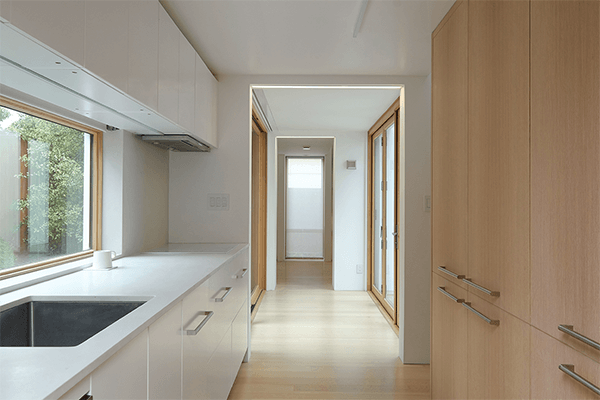Net-Zero Starts from the Floor Up: Why Radiant Heat is Non-Negotiable
![]() The standard for high-performance buildings has evolved beyond general “green” concepts to a more ambitious and measurable goal: the Net-Zero Energy (NZE) home. An NZE home is defined as a building that produces as much energy as it consumes annually. This is achieved through a combination of radical energy efficiency and on-site renewable energy generation, resulting in minimal utility costs and a significantly reduced carbon footprint.
The standard for high-performance buildings has evolved beyond general “green” concepts to a more ambitious and measurable goal: the Net-Zero Energy (NZE) home. An NZE home is defined as a building that produces as much energy as it consumes annually. This is achieved through a combination of radical energy efficiency and on-site renewable energy generation, resulting in minimal utility costs and a significantly reduced carbon footprint.
This article will define the core principles of NZE design and explain the foundational role that a high-performance space conditioning system, such as the Warmboard Comfort System, plays in achieving this standard.
Defining the Net-Zero Energy Home
At its core, an NZE home is an integrated system that relies on two key principles:
- Maximized Energy Efficiency: The building must first minimize its energy demand. This is accomplished through a superior building envelope, including high-grade insulation, airtight construction to prevent thermal loss, high-performance windows, and energy-efficient appliances.
- On-Site Renewable Energy Generation: To offset the home’s remaining energy consumption, an on-site system, such as photovoltaic (solar) panels, generates the necessary power for the household.
When the home’s energy use is successfully balanced between energy consumption and energy production, it has achieved “net-zero”.
Expanding the Scope: Net-Zero for Custom and Luxury Homes
A common misconception is that net-zero homes are limited to small, minimalist structures. While a compact design can certainly simplify efficiency goals, the NZE standard is increasingly being applied across a wide spectrum of residential projects, from custom builds to large luxury estates.
In the luxury market, net-zero is becoming the new benchmark for responsible, high-performance living. For these homeowners, the objective is not just lower energy bills, it’s a commitment to superior comfort, occupant health, and future-proofing their investment with advanced, sustainable technology without compromising on sophisticated architectural design.
The Critical Role of Space Conditioning in Achieving Net-Zero

This is where hydronic radiant floor heating, specifically the Warmboard Comfort System, becomes a foundational component for net-zero projects. Its performance characteristics offer distinct advantages:
- Superior Thermodynamic Efficiency: Warmboard operates with lower water temperatures (as low as 85-120°F) compared to traditional radiant systems or high-temperature baseboards (160-180°F). Its highly conductive aluminum surface transfers heat more rapidly and efficiently into the space. This makes it an ideal partner for modern, high-efficiency heat pumps, which operate at their highest Coefficient of Performance (COP) when producing the lower water temperatures that Warmboard is specifically engineered to use.
- Enhanced Thermal Comfort and Indoor Air Quality: NZE homes prioritize the well-being of their occupants. Because these homes are built to be exceptionally airtight, they require dedicated mechanical ventilation systems—such as a Heat Recovery Ventilator (HRV) or Energy Recovery Ventilator (ERV)—to ensure a constant supply of fresh, filtered air. This creates an opportunity to decouple the home’s heating and ventilation systems. While the ventilation system manages air quality, the radiant system can focus solely on providing superior thermal comfort. Unlike forced-air systems that can circulate dust and allergens, radiant heat warms objects and surfaces directly, providing consistent warmth without drafts or noise. This separation of functions results in a healthier and more comfortable indoor environment.
- Architectural and Design Flexibility: For architects designing high-performance homes, Warmboard allows for greater design freedom. The system’s effectiveness is not compromised by features common in modern, sustainable design, such as large, high-performance windows, open-concept floor plans, and vaulted ceilings.
- Lowering the Overall Heating Load: Because it delivers heat so effectively, the Warmboard system reduces the total energy (measured in BTUs) required for space heating. This smaller heating load makes it easier for the on-site renewable energy system to offset the home’s total energy consumption, helping to make net-zero goals more attainable.
Are you designing or building a net-zero home? Consider how the foundational choice of a high-performance radiant system can elevate its efficiency and comfort. To see how Warmboard can be incorporated into your project, submit your floor plan for a custom proposal.
Warmboard projects with Net Zero emissions
Explore our case studies of net zero builds:
• Beyond NetZero in Aspen, Colorado
• LEED Gold NZE in New York